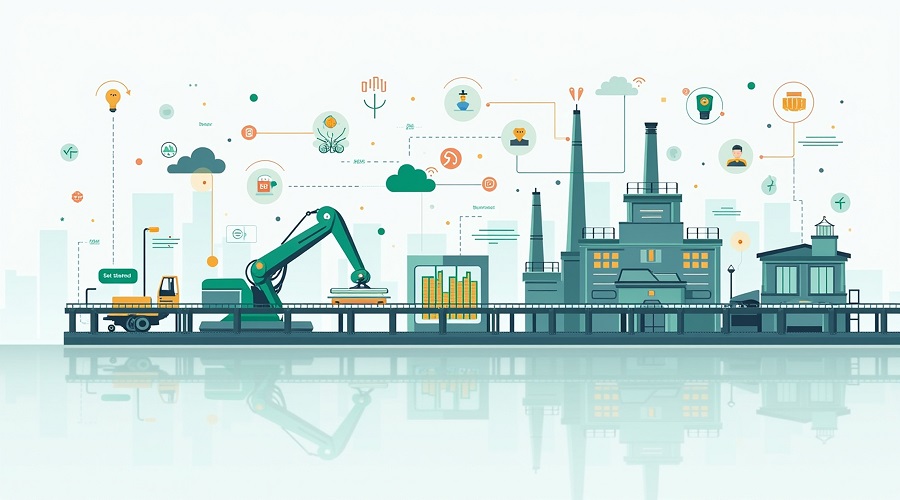Discover how ‘Industry 4.0’ is transforming factories into intelligent ecosystems that boost efficiency, resilience, and growth.
Why Industry 4.0 Matters
Industry 4.0 isn’t just jargon it signals a game changing shift in manufacturing. By harnessing real time data, connected devices, and automation, this new industrial era empowers businesses to produce smarter, faster, and more sustainably. Whether you’re a factory manager facing rising costs, a strategist aiming for scalability or a technologist seeking competitive edge, it offers the tools and methodologies to meet modern challenges head on.
In this blog, you’ll learn how to embrace this shift, the core technologies involved, and the steps to make it work for your organization.
What Exactly Is Industry 4.0?
Industry 4.0 marks the fourth major revolution in manufacturing. It follows mechanization, mass production, and digitization. What sets it apart is its emphasis on connectivity robots, sensors, and systems communicate and make decisions with minimal human intervention. Think smart factories where equipment self optimizes and supply chains react in real time. That’s the promise of Industry 4.0.
Core Technologies Driving the Change
- Internet of Things (IoT): Imagine sensors on machines sending live data. IoT networks gather this data to monitor performance, predict failures, and optimize maintenance schedules. That’s real time insight in action.
- Artificial Intelligence & Machine Learning: AI learns from production data to flag inefficiencies, forecast demand, and refine processes. Machine learning models identify quality issues before they escalate, minimizing defects and waste.
- Robotics and Automation: Collaborative robots “cobots” work alongside humans to automate repetitive or dangerous tasks. This not only speeds up processes but also frees staff for more creative problem solving roles.
- Digital Twins: These virtual replicas mirror real-world assets. Engineers test changes in a virtual environment first, reducing downtime, optimizing performance, and speeding up innovation.
- Edge & Cloud Computing: Edge devices handle critical tasks locally for speed, while the cloud processes large-scale analytics. Together, they balance performance and scalability.
- Cyber Physical Systems & 5G: These systems blend hardware and software, enabling autonomous decision making. Add 5G’s low latency and reliable connectivity, and production becomes more agile and resilient.
Why Industry 4.0 Should Be on Your Radar
- Improved Efficiency: Automation and predictive analytics cut downtime and streamline workflows.
- Quality and Customization: Realtime feedback ensures fewer defects, while production lines adapt to bespoke orders.
- Cost Reduction: Proactive maintenance and leaner processes reduce expenses and unexpected breakdowns.
- Better Data Driven Decisions: Dashboard insights empower teams to make smarter choices rapidly.
- Sustainability Boost: Optimized energy use and resource efficiency help businesses go greener.
How to Get Started
- Evaluate Your Current Setup: Map out your production line, IT systems, and data collection methods. This provides a baseline.
- Define Strategic Goals: Do you want to reduce downtime, improve quality, or ramp up custom orders? Clear objectives help guide tech adoption.
- Start Small with a Pilot: Choose one process like predictive maintenance and test a solution before a full-scale roll-out.
- Invest in People and Training: Technologies won’t succeed without skilled staff. Offer upskilling and create multi-disciplinary teams.
- Build Scalable Architecture: Opt for modular IoT+edge solutions so future growth doesn’t mean total overhaul.
- Secure Your Ecosystem: As devices connect, cybersecurity risks grow. Encrypt data, secure access, and stay compliant with industry standards.
Real-World Wins that Showcase Industry 4.0
- A European car manufacturer reduced unplanned downtime by over 30% using predictive analytics on machinery.
- A packaging plant deployed cobots to lift and pack items, increasing productivity by 25% without sacrificing worker safety.
- A medical devices firm implemented digital twins to simulate production changes cutting time to market by weeks.
Industry 4.0: What’s Next?
- 5G adoption will supercharge factory connectivity.
- AI advancements will enable smarter, more autonomous processes.
- Sustainability integration: Industry 4.0 and green practices will increasingly go hand in hand.
- Interoperable ecosystems where suppliers, logistics and customers connect seamlessly.
FAQs:
1. What is Industry 4.0?
Industry 4.0 is the integration of cyber physical systems in manufacturing using IoT, AI, robotics, edge/cloud computing, and advanced communications to create smart, connected production lines.
2. Who benefits from adopting Industry 4.0?
Manufacturers of any size stand to gain especially those targeting higher efficiency, better quality, flexibility, and sustainability in production.
3. How much does it cost to implement?
Costs vary depending on scope and depth. Pilot programmes can begin with modest budgets (USD 10k–50k), with ROI visible within months of rollout.
4. What’s the best starting point for Industry 4.0?
Start with a focused pilot such as predictive maintenance on one critical machine or automating high volume task to prove value before scaling.
5. Is cybersecurity a big concern?
Yes. As more devices connect, data becomes a target. Successful Industry 4.0 implementations invest simultaneously in encryption, access controls, and continuous monitoring.





Comments